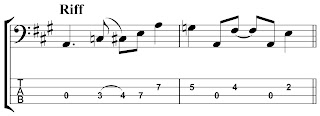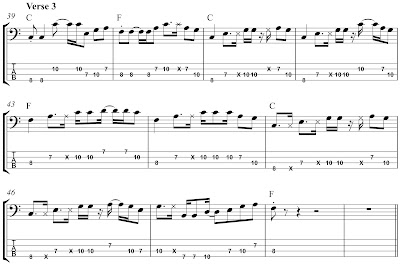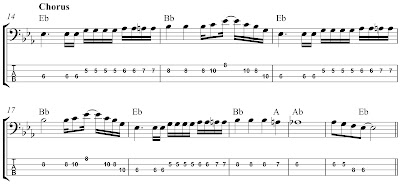Coming Home
(Bonnie Bramlett and Eric Clapton)
From the Delaney & Bonnie album On Tour with Eric Clapton
Released as a single in Europe, "Coming Home" is the signature song from the Delaney & Bonnie album On Tour With Eric Clapton. The songwriting credit goes to Bonnie Bramlett and Eric Clapton, but it was almost certainly a collaboration between Clapton and Delaney.
The song is built around a two-measure guitar riff in A. Radle plays a complementary bass riff that locks in well with the guitars, becoming a sort of secondary hook. Being that there were four guitars, keyboards, and a horn section all playing in roughly the same register, Radle's bass cuts through very well as he was not competing with anything else in the lower register.
During the verses, Radle shifts to a line with a little less movement, but a bit more syncopation, which keeps propelling the line forward to the next downbeat. Though he adds slight embellishments to the line fairly regularly, most of the song can be played with just the two-measure riff and the two-measure verse groove.
There is also a simple bridge in E that occurs only once. This is the only harmonic change in the entire song. The rest of it is just riffs in A major.
Monday, September 23, 2019
Dirty Old Man
Dirty Old Man
(Delaney Bramlett and Mac Davis)
From the Delaney & Bonnie album Accept No Substitute
Unlike Home, 1969's Accept No Substitute (also known as The Original Delaney & Bonnie) featured the same backing band on the entire album. The core of this band, which included Radle, Bobby Whitlock, Rita Coolidge, and Bobby Keys, would remain with Delaney & Bonnie for the rest of the year, touring England and the European continent in late 1969 and early 1970.
"Dirty Old Man" is kind of a modified twelve-bar blues with a bridge. (The first two verses are actually 13 bars each.) Radle's bass line is build largely on arpeggios. The root-3rd-5th-6th pattern is typical of a lot of blues songs, but this one is infused with an R&B groove. Instead of being a shuffle, which implies a triplet subdivision of each beat, the groove here has a sixteenth note subdivision. Radle plays essentially the same line for verses 1 and 2.
Radle uses lots of ghost notes to propel the song forward. Syncopations occur almost exclusively on beats 3 and 4. The following rhythmic pattern appears frequently in his line:
This is a common figure in R&B and soul music. In fact, it is not unlike the syncopation Radle uses in the choruses of "Piece of My Heart."
The bridge serves as a bit of relief from the repetition of the verses, but also allows the band to modulate up a half-step to C. Radle keeps the same type of 16th note syncopation, but his line sounds much more improvisatory than it did in the verses.
After the bridge, the band goes through a verse in C Major. Radle keeps essentially the same groove.
The outro is just a vamp from C to F. Radle continues his verse groove, but with added embellishments, particularly on the F chords.
(Delaney Bramlett and Mac Davis)
From the Delaney & Bonnie album Accept No Substitute
Unlike Home, 1969's Accept No Substitute (also known as The Original Delaney & Bonnie) featured the same backing band on the entire album. The core of this band, which included Radle, Bobby Whitlock, Rita Coolidge, and Bobby Keys, would remain with Delaney & Bonnie for the rest of the year, touring England and the European continent in late 1969 and early 1970.
"Dirty Old Man" is kind of a modified twelve-bar blues with a bridge. (The first two verses are actually 13 bars each.) Radle's bass line is build largely on arpeggios. The root-3rd-5th-6th pattern is typical of a lot of blues songs, but this one is infused with an R&B groove. Instead of being a shuffle, which implies a triplet subdivision of each beat, the groove here has a sixteenth note subdivision. Radle plays essentially the same line for verses 1 and 2.
Radle uses lots of ghost notes to propel the song forward. Syncopations occur almost exclusively on beats 3 and 4. The following rhythmic pattern appears frequently in his line:
This is a common figure in R&B and soul music. In fact, it is not unlike the syncopation Radle uses in the choruses of "Piece of My Heart."
The bridge serves as a bit of relief from the repetition of the verses, but also allows the band to modulate up a half-step to C. Radle keeps the same type of 16th note syncopation, but his line sounds much more improvisatory than it did in the verses.
The outro is just a vamp from C to F. Radle continues his verse groove, but with added embellishments, particularly on the F chords.
Piece of My Heart
Piece of My Heart
(Composed by Jerry Ragovoy and Bert Berns)
From the Delaney & Bonnie album Home
This track was featured on Delaney & Bonnie’s album Home, released on Stax Records in 1969. The rhythm section on much of the record was the Stax house band, Booker T. and the MGs. “Piece of My Heart” is one of two songs that utilize Carl Radle, Leon Russell, and Jimmy Karstein instead of the MGs. (Radle also plays on two of the bonus tracks included on the 2006 CD release.)
During the verses, Radle plays a very simple dotted quarter-eighth note pattern, typical of medium tempo songs. There is a clear hierarchy in the verses of this song. Bonnie’s vocal is the primary focus. Delaney’s guitar fills are secondary. Radle’s role is to be supportive and stay out of the way. This bass line provides a lot of space for Bonnie to be expressive with her vocal, and it does not interfere with Delaney’s guitar fills.
(Composed by Jerry Ragovoy and Bert Berns)
From the Delaney & Bonnie album Home
This track was featured on Delaney & Bonnie’s album Home, released on Stax Records in 1969. The rhythm section on much of the record was the Stax house band, Booker T. and the MGs. “Piece of My Heart” is one of two songs that utilize Carl Radle, Leon Russell, and Jimmy Karstein instead of the MGs. (Radle also plays on two of the bonus tracks included on the 2006 CD release.)
During the verses, Radle plays a very simple dotted quarter-eighth note pattern, typical of medium tempo songs. There is a clear hierarchy in the verses of this song. Bonnie’s vocal is the primary focus. Delaney’s guitar fills are secondary. Radle’s role is to be supportive and stay out of the way. This bass line provides a lot of space for Bonnie to be expressive with her vocal, and it does not interfere with Delaney’s guitar fills.
Radle gets to step out a little more during the choruses. The
energy of the whole band ramps up, and Radle responds by moving from the
long-note groove of the verse to a primarily sixteenth note line in the chorus.
He also provides a nice counterpoint to the vocal. As Bonnie’s melody descends,
Radle’s bass line ascends Eb-G-Ab-A-Bb (see mm. 14-15). He then punctuates the
phrase with the syncopated riff on beats 3 and 4 of the Bb chord.
Radle provides almost no variation in the groove from verse to verse. He experiments a bit more in the chorus, particularly as the song builds towards the end. Most of the embellishments occur over the Bb chord as the band repeats the chorus three times before ending. So, even as the song builds to a frenzy, Radle is carefully choosing his spots to bring a bit of flash.
Keep On Growing
Keep On Growing
(Eric Clapton and Bobby Whitlock)
From the Derek & the Dominos album Layla and Other Assorted Love Songs
The tuning is between A and Bb. Likely the band recorded in A, but afterwards decided it was too slow, so they sped up the tape a little, thus increasing the pitch. The song begins with a short intro.
"Keep On Growing" highlights several important aspects of Carl Radle's style. His line on the chorus is a very simple and repetitive arpeggiation of an A-D chord progression. He seldom makes any variations on this pattern. Even when the band vamps on this two-chord groove for the last two minutes of the song, Radle sticks to this line with a few extra ghost notes as his only embellishments.
The chord
progression in the verse is also A-D, but here each chord is a full measure
instead of a half-measure. Again, Radle sets up a one-measure groove and sticks
to it, not even altering it when the chord changes. Thus, the bass line acts as
a sort of pedal point. The repetition of the line against the changing
harmony creates a lot of tension which is (temporarily) released in the fourth
bar with the G-D-A cadence.
During the
bridge, Radle helps the song “open up” by playing longer phrases that move
through the changes melodically. The contrast between the moving line of the
bridge and the short repetitive patterns in the rest of the song creates a
large-scale tension/release that mirrors the tension/release that occurs every
four measures within each verse.
Friday, September 20, 2019
August 1976 Interview
Below is an interview with Carl Radle from the August 1976 issue of Guitar Player. This is the most in-depth interview with him I've been able to find.
Thursday, September 19, 2019
Introduction
This is a new blog about the bass player Carl Radle (1940-1980). Radle played on recordings by Eric Clapton, George Harrison, Leon Russell, Delaney & Bonnie, J. J. Cale, Buddy Guy, Joe Cocker, and so many others. I have transcribed a lot of his bass lines and plan to post them here along with some analysis or description of them. For me, it's not just important to be able to play his bass lines. It is important to understand what makes them work, so they can be learned from, rather than just reproduced.
I am also working on a comprehensive discography of recordings Radle played on. Sometimes he was the bass player for an entire album, sometimes it was only a couple of songs. Information about this is scattered all over the internet, so I would like to compile it all into one location.
As a staff writer for Bass Musician Magazine from 2011 to 2013, I wrote articles analyzing the playing styles of bassists such as Rick Danko, Paul McCartney, Duck Dunn, and Sting. The first article I wrote for the magazine was about Carl Radle. It was published in 2011 as a reader submission, before I was officially a staff writer. That article is at the link below.
Subscribe to:
Posts (Atom)

















